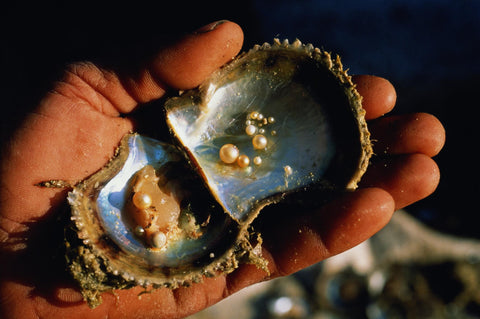Nothing better describes how precious pearls are than the myth about Cleopatra dissolving a large pearl in vinegar and drinking the potion in a demonstration of her infinite wealth.
Forming a cultured pearl requires human intervention by helping to start production process in the mollusc. The process of depositing layers of nacre, the substance that forms the pearl, around the irritant just as is in the case of natural pearl marks the beginning of the production of cultured pearls by inserting a piece of mantle tissue or a round bead into the mollusc.
Cultured Pearls
It is pertinent to point that for the most part, telling a cultured pearl apart from a natural is something that is almost impossible to achieve. This is on account of the fact that cultured pearls are still real pearls grown organically in the exact same way as natural pearls despite its development being sparked by the insertion of “nucleus” into the oyster as described above. Cultured pearls are more or less the same size after harvest and can be treated or bleached by farmers before sale or adding it to a piece of jewellery. Cultured pearls are farmed using two different groups of bivalve mollusc like the freshwater river mussels, and the saltwater pearl oysters.
After surgically implanting the small shell bead alongside the tiny piece of mantle tissue, the nucleated oysters are afterwards taken back to the sea enclosed in individual mesh pockets which suspended from floating rafts. This process makes it possible for the oysters to feed and blossom in the sheltered bays with plenty naturally rich nutrients. As time rolls by, the oysters conceal glossy layers of nacre around the implanted bead. The oysters are moved to warmer waters during the winter. After this is done, pearl technicians then observe water temperatures and feeding conditions on a daily basis and at different water depths with the intention of moving the oysters to the most suitable growing conditions.
Natural Pearls
The oysters are occasionally lifted from the sea in order to clean and attend to their health. Growths like barnacles and seaweeds, alongside a host of others are then taken away from their shells and treated with compounds to thwart parasites from harming the oysters’ tender flesh. The precious oysters as scrupulously defended from every thinkable danger in order to ensure that fines pearls are produced.
Then there’s the danger of red tides of plankton alongside predators and typhoons all striking even before the pearls are harvest-ready. Soon as the oysters are returned back to shore, the pearl farmers take stock of the much-awaited harvest. This is because, despite the millions of oysters that are nucleated each year, only a tiny fraction of them transform into high-grade pearls. Such is the danger of farming cultured pearls. It is also worth pointing out that close to half of the nucleated oysters do not even survive to the point where they can bear pearls. Only less than five percent of the survivors bring forth pearls of the ideal shape, colour, and lustre worth classifying as fine quality. The few lucky pearls that make it out of the brimstone and thunder unscathed are then cleaned, soaked, and sorted and made ready for the next phase of the production set up. It is hurdles such as these that reveal just why pearls are considered as precious.

The few successful set of pearls is afterwards made to undergo a series of gentle treatments in order to prepare them for jewellery. First set taken at this point is to soak them for a few days in a mild cleaning solution placed under intense fluorescent light, in order to take away any deposits and odours they may have amassed during their days of tribulation in the ocean. The new guys in the setup of precious gems are then soaked in a wooden vat of well-made crushed walnut shells. The new pearls’ preciousness begins to unfurl when the natural oils from the shells provide a soft and gentle polish without injuring the honour of the pearl's surface. After receiving their worthily luscious spa treatments, they become matched, albeit painstakingly.
Pearl Farms
In order to assemble a single strand, farm workers are made to comb through thousands of pearls so to discover the ones that match for shape, size, colour, lustre and surface quality in general. The first step to achieving this is to pour the pearls into special sieves meant for separating them into size groups. Afterwards, they are then sorted into increasingly smaller based on body-colour, shape, overtone and quality. It must be pointed out that this stage can take several months to complete. At least, comfort can be taken in the knowledge that nothing good is easy to create.
After the above stated process is completed, the pearls finally become ready for drilling and mounting. But before a pearl is set into a piece of fine jewellery, it usually undergoes more severe screening treatments. The matched pearls are further set apart into perfect pairs to create, say, a pair of earrings, or a well-matched group carefully arranged to make a subtly graduated strand as a mark of their honor. One after the other, each pearl is separately drilled and strung onto temporary strands referred to as loose hanks. Such hanks are sold at auction. There, your new gemstone all set to be sold on Otomo.
source https://www.otomo.co.uk/blogs/news/how-are-cultured-pearls-made
No comments:
Post a Comment